Write a program to solve a Sudoku puzzle by filling the empty cells.
A sudoku solution must satisfy all of the following rules:
- Each of the digits
1-9must occur exactly once in each row. - Each of the digits
1-9must occur exactly once in each column. - Each of the digits
1-9must occur exactly once in each of the 93x3sub-boxes of the grid.
The '.' character indicates empty cells.
Example 1:

Input: board = [["5","3",".",".","7",".",".",".","."],["6",".",".","1","9","5",".",".","."],[".","9","8",".",".",".",".","6","."],["8",".",".",".","6",".",".",".","3"],["4",".",".","8",".","3",".",".","1"],["7",".",".",".","2",".",".",".","6"],[".","6",".",".",".",".","2","8","."],[".",".",".","4","1","9",".",".","5"],[".",".",".",".","8",".",".","7","9"]] Output: [["5","3","4","6","7","8","9","1","2"],["6","7","2","1","9","5","3","4","8"],["1","9","8","3","4","2","5","6","7"],["8","5","9","7","6","1","4","2","3"],["4","2","6","8","5","3","7","9","1"],["7","1","3","9","2","4","8","5","6"],["9","6","1","5","3","7","2","8","4"],["2","8","7","4","1","9","6","3","5"],["3","4","5","2","8","6","1","7","9"]] Explanation: The input board is shown above and the only valid solution is shown below:
Constraints:
board.length == 9board[i].length == 9board[i][j]is a digit or'.'.- It is guaranteed that the input board has only one solution.
就是简单的回溯啊~~~~~~~~~ 你那样用手做的方法,很可能做不出来的。
Mistakes:
1: 刚开始,就是用的手算的思路。但是,不用回溯,是不行的。 哎~~~~~~~~~~
2:ArrayList 调用remove方法时, 当我们想remove Object时,但是, 我们的object是Integer。这时候,我们就不能直接remove Integer, 需要先找到其的index,再remove
3: 同样的回溯, 你写的就是太慢, 别人写的,就快啊
原本,我们这样写
boolean[] findFlag = new boolean[10];
// check the line of (row,col)
for (int j = 0; j < 9; j++) {
char ch = board[row][j];
if (ch == '.')
continue;
int value = Integer.valueOf("" + ch);
if (findFlag[value]) {
return false;
} else {
findFlag[value] = true;
}
}
对手是用了HashSet --------------应该,我们以前的也没问题的。 代码里,少写了个+3
Learned:
1: Cannot create a generic array of ArrayList<Integer> 所以说,下面这句是不对的
ArrayList<Integer>[][] candidites = new ArrayList<Integer>[9][9];
2 -------------------下面是别人的东东----------------
3 可以考虑“先放置,再判断”的方案。比如这里,首先判断当前位置是否为空,如果为空,那么放置一个元素,检查它是否正确。如果正确,就继续进行下面的递归 (也就是第29行 isValid&&solveSudoku的作用)。当函数返回错误之后,将刚刚的数值变为空,再进行下一次尝试即可。
4 所有的方案(k从1到9)完毕之后,应该返回错误,这个是不应该被忽略的。
5 最后一点需要注意的是,当i,j循环完毕之后,第36行应该返回true。这里实际上是最终/最底层的一次循环,表明已经解出了sudoku,返回true!切记切记,最终情况!
Mistakes:
2: 在试完了所有的9种可能填的选项之后,应该直接返回false了,而不是等待其最后返回true.
class Solution {public:void solveSudoku(vector<vector<char>>& board) { helper(board); }private:bool helper(vector<vector<char>>& board) {for (int i = 0; i < 9; i++) {for (int j = 0; j < 9; j++) {if (board[i][j] == '.') {for (char ch = '1'; ch <= '9'; ch++) {board[i][j] = ch;if (isValid(board, i, j) && helper(board))return true;}board[i][j] = '.';return false; // cannot set any valid value here}}}return true;}bool isValid(vector<vector<char>>& board, int row, int col) {char target = board[row][col];// check local 3*3int startRow = row / 3 * 3, startCol = col / 3 * 3;for(int i = startRow; i<startRow+3; i++){for(int j = startCol; j < startCol +3; j++){if(board[i][j] == target && !(i == row && j == col )){return false;}}}// check rowfor(int j = 0; j<9; j++){if(j != col && board[row][j] == target)return false;}// check that coloumfor(int i = 0; i<9; i++){if(i != row && board[i][col] == target)return false;}return true;}};
Mistakes:
1: 刚开始,就是用的手算的思路。但是,不用回溯,是不行的。 哎~~~~~~~~~~
2:ArrayList 调用remove方法时, 当我们想remove Object时,但是, 我们的object是Integer。这时候,我们就不能直接remove Integer, 需要先找到其的index,再remove
3: 同样的回溯, 你写的就是太慢, 别人写的,就快啊
原本,我们这样写
boolean[] findFlag = new boolean[10];
// check the line of (row,col)
for (int j = 0; j < 9; j++) {
char ch = board[row][j];
if (ch == '.')
continue;
int value = Integer.valueOf("" + ch);
if (findFlag[value]) {
return false;
} else {
findFlag[value] = true;
}
}
对手是用了HashSet --------------应该,我们以前的也没问题的。 代码里,少写了个+3
Learned:
1: Cannot create a generic array of ArrayList<Integer> 所以说,下面这句是不对的
ArrayList<Integer>[][] candidites = new ArrayList<Integer>[9][9];
2 -------------------下面是别人的东东----------------
做了这道题,对backtracking的理解又加深了一点点。
1 每个backtracking的题目,最好都有独立判断isValid的程序,这样架构清楚。同时,valid判断函数在这里可以稍微研究一下。只要当前要判断的位置上的数值和本行没有重复,本列没有重复,九宫格没有重复就可以。一旦重复立即返回,减少判断次数。
2 backtracking的递归函数,怎么能没有返回值呢?!因为要判断递归的方案正确与否,所以这里的递归一定是有返回值的(除非是combination那种没有正确错误概念的backtracking)!3 可以考虑“先放置,再判断”的方案。比如这里,首先判断当前位置是否为空,如果为空,那么放置一个元素,检查它是否正确。如果正确,就继续进行下面的递归 (也就是第29行 isValid&&solveSudoku的作用)。当函数返回错误之后,将刚刚的数值变为空,再进行下一次尝试即可。
4 所有的方案(k从1到9)完毕之后,应该返回错误,这个是不应该被忽略的。
5 最后一点需要注意的是,当i,j循环完毕之后,第36行应该返回true。这里实际上是最终/最底层的一次循环,表明已经解出了sudoku,返回true!切记切记,最终情况!
Mistakes:
2: 在试完了所有的9种可能填的选项之后,应该直接返回false了,而不是等待其最后返回true.
No comments:
Post a Comment